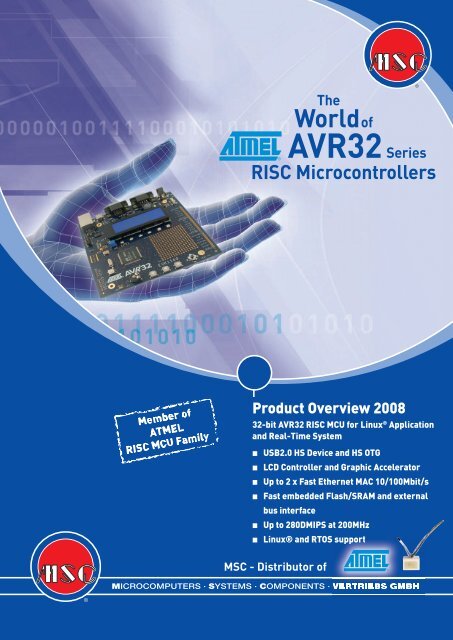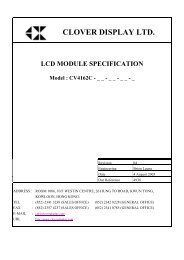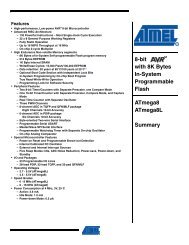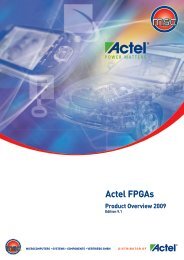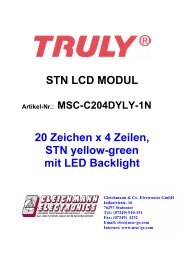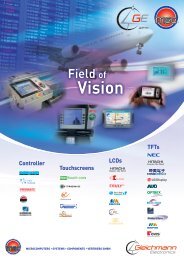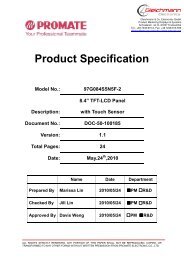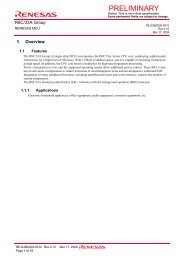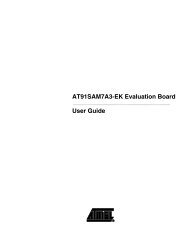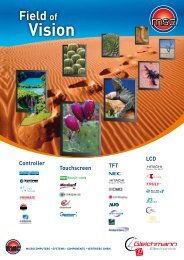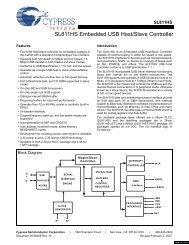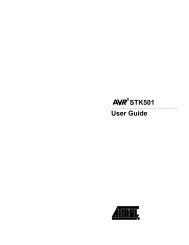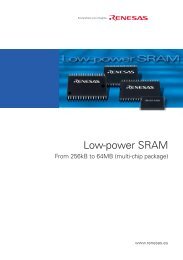AVR32 Series - MSC Budapest Kft.
AVR32 Series - MSC Budapest Kft.
AVR32 Series - MSC Budapest Kft.
- No tags were found...
You also want an ePaper? Increase the reach of your titles
YUMPU automatically turns print PDFs into web optimized ePapers that Google loves.
<strong>AVR32</strong> RISC MCU FamiliesWelcome to the World of Atmel’s RISC microcontrollersJoin the big world of Atmel’s 8-bit and 32-bit RISC MCU families!From lowest cost ATTINY, high performance ATMEGA or new XMEGA family, Atmel’s 8-bit AVR portfolio covers devices from 16MIPS up 32 MIPS with pin counts from 8 up to 100 pins. Flash memories from 1K up to 256K are available.Atmel’s RISC architecturesAtmel’s new <strong>AVR32</strong> 32-bit core is introduced in UC3 flash based derivates and in the AP7 application processor products. A lotof intelligent technologies make this core the winner in performance and power consumption over all existing 32-bit technologies.Here, will find flash based products up to 512K with a lot of communication interfaces as well as high performance processorswith MMU and cashes especially for embedded Linux, which is supported directly by Atmel.Atmel’s SAM ARM® families cover a broad range of products from flash based SAM7 and SAM9 products as well as biggerSAM9 machines for Windows CE® and embedded Linux.A rich set of communication peripherals, lots of smart implementations and different available development tools and operatingsystems in the market make this products very successful.Common peripheralsMigrationBoth <strong>AVR32</strong> and SAM ARM® use many common peripherals,enabling migration between the families much more easier,than jumping between different MCU technology.Common toolsTools<strong>AVR32</strong>, AVR and XMEGA products come with dedicated freeof charge AVR Studios and can be debugged with JTAGICE-MK2. So feel free to start with AVR, enlarge your applicationto XMEGA and proceed to <strong>AVR32</strong> MCUs with the same set oftools.2
<strong>AVR32</strong> Family OverviewAP7 Family RoadmapThe <strong>AVR32</strong> Family is currently the most expanding product in the 32-bit area. This is valid for both, the flash-less AP7 Familyand the embedded flash UC3. The AP7 family is equipped with all system components and peripherals to build up digitalsystems for process controlling and visualization which normally are engaged with full fledged operating system like Linux.The AT32AP7000 was the first product on the market which features highest performance at low power consumption and wastargeting to the portable console market. But the huge offer in software, specially the Linux Kernel and driver support directlyfrom Atmel, was ideal for a lot of customer to use this package for their application. All next products based on AP7 will havenew or additional peripherals and also will be shrinked for more speed and lower power consumption.UC3 Family RoadmapThe UC3 family is an optimized version of the <strong>AVR32</strong> Core for real-time systems and will be equipped with embedded flash. Itoptimally fits into application where highest performance at low power consumption is needed and also PCB space is less available.The UC3 Core implements a high efficient DSP instruction set and speed up signal processing applications significantly.The UC3 family is planned to be automotive AEC-Q100 as well.3
Family Overview AT32AP7000The AT32AP7000 is the first <strong>AVR32</strong>-based processor family and the first to integrateon a single chip, virtually all the functionalities required for multimedia systemsdeployed in cell phones, digital cameras, PDAs, automotive infotainment, set topboxes, and home entertainment systems, as well as network switches/routers andprinters. The embedded Pixel-Coprocessor accelerates processing of images andvideo streams and is directly connected to the core to perform single cycle executionon processor speed.The AT32AP7000 operates at 210 MIPS with a 150 MHz clock. It features 32K bytesof SRAM directly connected to the high-speed bus matrix, an external bus interfacewith controllers for SDRAM and static memories including NAND Flash and CompactFlashwith ECC. Its extensive peripheral set includes an USB High Speed Deviceinterface, two 10/100 Base-T Ethernet MAC, Image Sensor Interface, MultimediaCard Interface (MCI), a LCD-Controller for TFT and STN Displays, SynchronousSerial Controllers (SSC), USARTs, Master/Slave Serial Peripheral Interfaces (SPI),two three-channel 16-bit Timer Counter (TC) and a Two Wire Interface (TWI). Up tofive GPIO Controller (each 32-bit wide) are selecting general I/O’s or do connect theperipherals to dedicated pins via multiplexer. Peripheral DMA channels maximizethe data throughput between these interfaces and the on- and off-chip memories.The AT32AP7000 is available in a 256-ball CTBGA RoHS-compliant package providingup to 160 GPIO multiplexed with peripherals.AT32AP7000 in brief7DebugCachesMMUSystemMemory<strong>AVR32</strong>, 150MHzPixel-Coprocessor16-layer AHB MatrixJTAG / Nexus Class III16K-I, 16K-DyesFlash -SRAMExt. Bus interfaceBootEthernetUSB UDPUHPU(S)ART2 x 16KB8/16/32-bit static,16/32-bit dynamic,NAND (ECC), CompactFlashCommunicationEBI CS02 x MAC 10/100 RMII/MIIwith DMA1 USB2.0 HS Device4 with DMAAT32AP7000 BlockdiagramSPITWI (I²C)SSC2 with DMA1 (Master)3 with DMATimer16-bit6 x with Cap/ComRTT 1Watchdog 1PWM4 ch / 20-bitMultimediaLCD Contr.2048 x 2048 24-bitCamera IF 1MMC IF 1Audio DAC 1AC97 1Misc.PS2 1AT32AP7000 Development ToolsAP7000 is supported by the ATSTK1000 evaluation kit and AT90JTAGICE-mkIIdebugger. Also an ultra low-cost Network Reference Design Kit ATNGW100 withpre-installed Linux Image is available.All related Software and documentation may be downloaded via www.atmel.com/products/avr32 :- Ready to use example projects- Linux demonstration software- Getting Started Application Notes- Schematics, BOM and Gerber files- Free Atmel tools (Linux Kernel and BSP)ATSTK1000 is equipped with AT32AP7000-CTUT (CTBGA).<strong>MSC</strong>’s AT32AP7000-Startup Paket gives you all you need for your first AP7000design: ATSTK1000, AT90JTAGICE-mkII. The BSP and Linux Kernel is supported byAtmel and can be downloaded free of cost.I/O160 max.Oscillators2 x Osc., 2 x PLLSystemPOR, Shut Down Ctrl.Evaluation BoardsATSTK1000 ResourcesSDRAM8MByteFlash8MByteSD-Card256MByteATNGW100 ResourcesSDRAM32MByteFlash8MByteDataFlash8MByteSchematics, BOM, Gerber etc. provided by Atmel.4
Family Overview AT32AP7002The AT32AP7002 is a device reduction of the full-fledged AP7000 related to someperipherals. It can be used in applications where no Ethernet connection is neededbut process visualization is an issue. The AP7002 can be used for applicationsdeployed in cell phones, digital cameras, automotive infotainment, process automation,set top boxes, and home entertainment systems. The embedded Pixel-Coprocessoraccelerates processing of images and video streams and is directly connectedto the core to perform single cycle execution on processor speed.The AT32AP7002 operates at 210 MIPS with a 150 MHz clock. It features 32K bytesof SRAM directly connected to the high-speed bus matrix, an external bus interfacewith controllers for SDRAM and static memories including NAND Flash andCompactFlash with ECC. Its extensive peripheral set includes a USB High SpeedDevice interface, Image Sensor Interface, Multimedia Card Interface (MCI), aLCD-Controller for TFT and STN Displays, Synchronous Serial Controllers (SSC),USARTs, Master/Slave Serial Peripheral Interfaces (SPI), two three-channel 16-bitTimer Counter (TC) and a Two Wire Interface (TWI). Up to three GPIO Controller(each 32-bit wide) are selecting general I/O’s or do connect the peripherals to dedicatedpins via multiplexer. Peripheral DMA channels maximize the data throughputbetween these interfaces and the on- and off-chip memories.The AT32AP7002 is available in a 196-ball CTBGA RoHS-compliant package providingup to 88 GPIO multiplexed with peripherals.AT32AP7002 in briefCPUDebugCachesMMUSystemMemory<strong>AVR32</strong>, 150MHzPixel-Coprocessor16-layer AHB MatrixJTAG / Nexus Class III16K-I, 16K-DyesFlash -SRAMExt. Bus interfaceBootUSB UDPUHPU(S)ARTSPITWI (I²C)SSC2 x 16KB8/16/32-bit static,16/32-bit dynamic,NAND (ECC), CompactFlashCommunicationEBI CS01 USB2.0 HS Device4 with DMA2 with DMA1 (Master)3 with DMAAT32AP7002 Blockdiagram16-bitTimer6 x with Cap/ComRTT 1Watchdog 1PWM4 ch / 20-bitMultimediaLCD Contr.2048 x 2048 24-bitCamera IF 1MMC IF 1Audio DAC 1AC97 1Misc.PS2 1I/OOscillatorsSystem160 max.2 x Osc., 2 x PLLPOR, Shut Down Ctrl.AT32AP7000 Development ToolsAP7000 is supported by the ATSTK1000 evaluation kit and AT90JTAGICE-mkIIdebugger. Also an ultra low-cost Network Reference Design Kit ATNGW100 withpre-installed Linux Image is available.All related Software and documentation may be downloaded via www.atmel.com/products/avr32 :- Ready to use example projects- Linux demonstration software- Getting Started Application Notes- Schematics, BOM and Gerber files- Free Atmel tools (Linux Kernel and BSP)ATSTK1000 is equipped with AT32AP7000-CTUT (CTBGA).<strong>MSC</strong>’s AT32AP7000-Startup Paket gives you all you need for your first AP7000design: ATSTK1000, AT90JTAGICE-mkII. The BSP and Linux Kernel is supported byAtmel and can be downloaded free of cost.Evaluation BoardsATSTK1000 ResourcesSDRAM8MByteFlash8MByteSD-Card256MByteATNGW100 ResourcesSDRAM32MByteFlash8MByteDataFlash8MByteSchematics, BOM, Gerber etc. provided by Atmel.6
Family Overview AT32UC3AThe AT32UC3A is based on the high-performance <strong>AVR32</strong> core with logic optimizationfor real-time applications. Cache and MMU have been removed and instead amemory protection unit (MPU) was added. Also the core pipeline was reduced to a3-stage pipeline to achieve the requirements needed for real-time systems.The AT32UC3A operates at 80 DMIPS with a 66 MHz clock. It features up to 64Kbytes of SRAM directly connected to the core and performs single cycle access atmaximum processor speed. The AT32UC3A family is designed for communicationsystems providing fast Ethernet 10/100Mbits/s and Full-Speed USB2.0 OTG at verylow power consumption. Additional an external bus interface with controllers forSDRAM and static memories expands the embedded Flash and SRAM by cost effectivememory options and also do provide more system functionality. SynchronousSerial Controllers (SSC), many USART’s, Master/Slave Serial Peripheral Interfaces(SPI), two three-channel 16-bit Timer Counter (TC), a Two Wire Interface (TWI) and a10-bit ADC are part of this implementation and are speed up by the peripheral DMAcontroller to reduce CPU intervention. Up to 109-Pins are controlled by the ParallelI/O Controller and do switch connection for general purpose I/O’s or peripherals.AT32UC3A in briefCPUSystem<strong>AVR32</strong>, 66MHzHigh-Speed AHB MatrixDebug JTAG / Nexus Class 2+Caches -MPUFlashSRAMExt. Bus interfaceBootEthernetUSB UDPUHPMemoryCommunicationyes128/256/512KB32/64/64KB8/16-bit static,16-bit dynamic,DFU Bootloader1 x MAC 10/100 RMII/MIIwith DMA1 USB2.0 FS OTGThe AT32UC3A is available in a 144-pin TQFP RoHS-compliant package providingall described functionality and also in a 100-pin TQFP package with no external businterface.AT32UC3A BlockdiagramU(S)ARTSPITWI (I²C)SSC16-bit4 with DMA2 with DMA1 with DMA1 with DMATimer3 x with Cap/ComRTC 1Watchdog 1PWM7 ch / 16-bitAnalogueADC10-bit / 8chMisc.I/O 109/69OscillatorsSystem115KHz RC2 x Osc., 2 x PLLPOR, BODEvaluation BoardsATEVK1100 ResourcesAT32UC3A Development ToolsThe AT32UC3A is supported by ATEVK1100 evaluation kit and AT90JTAGICE-mkIIdebugger. It is pre-installed with a Panel Controller application also available insource code and support Mass-Storage Device Class a Web Server Application andmuch more. All source code is available through the UC3A Software Frameworkfree of cost.It may be downloaded via www.atmel.com/products/avr32 :- Ready to use example projects- Control Panel demonstration software- Getting Started Application Notes- Schematics, BOM, Gerber files- Free Atmel tools (<strong>AVR32</strong> Studio Integrated Development Tool)ATEVK1100 is equipped with AT32UC3A0512-ALUT (TQFP144).SDRAM 16Mbit (1M x 16)DataFlash8MByteSD-CardSlot onlyEthernetRJ-45USART2 x RS232USBMiniABDisplay4 x 20 Characters (SPI)Schematics, BOM, Gerber etc. provided by Atmel.8
Family Overview AT32UC3BThe AT32UC3B is based on the high-performance <strong>AVR32</strong> core with logic optimizationfor real-time applications. Cache and MMU have been removed and instead amemory protection unit (MPU) was added. Also the core pipeline was reduced to a3-stage pipeline to achieve the requirements needed for real-time systems.The AT32UC3B operates at 75 DMIPS with a 60 MHz clock. It features up to 32Kbytes of SRAM directly connected to the core and performs single cycle access atmaximum processor speed. The AT32UC3B family is designed for general purposelow pin-count applications providing Full-Speed USB2.0 OTG at very low powerconsumption. This family is specially fabricated in a very low leakage process whichresults in 23mA@60MHz at 3.3V and ideally fits into battery powered applications.Synchronous Serial Controllers (SSC), many USART’s, Master/Slave Serial PeripheralInterface (SPI), one three-channel 16-bit Timer Counter (TC), a Two Wire Interface(TWI) and a 10-bit ADC are part of this implementation and are speed up by theperipheral DMA controller to reduce CPU intervention. Up to 44-Pins are controlledby the Parallel I/O Controller and provide connections for general purpose I/O’s orperipherals.The AT32UC3B is available in a 64-pin TQFP and 64-pin QFN RoHS-compliant packageproviding all described functionality. Also a 48-pin TQFP package and a 48-pinQFN package with reduced functionality can be offered.AT32UC3B in brieffCPUSystem<strong>AVR32</strong>, 60MHzHigh-Speed AHB MatrixDebug JTAG / Nexus Class 2+Caches -MPUFlashSRAMBootUSB UDPUHPU(S)ARTSPITWI (I²C)SSC16-bitMemoryCommunicationTimeryes64/128/256KB16/32/32KBDFU Bootloader1 USB2.0 FS OTG3 with DMA1 with DMA1 with DMA1 with DMA3 x with Cap/ComRTC 1Watchdog 1AT32UC3B BlockdiagramPWMAnalogue7 ch / 16-bitADC10-bit / 8chMisc.I/O 44/28OscillatorsSystem115KHz RC2 x Osc., 2 x PLLPOR, BODEvaluation BoardsATEVK1100 ResourcesDataFlashSD-CardSensors8MByteSlot onlyAccelerometerLigth, TemperatureAT32UC3B Development ToolsThe AT32UC3B is supported by ATEVK1101 evaluation kit and AT90JTAGICE-mkIIdebugger. It is pre-installed with a Panel Controller application also available insource and a PC based Java based Dialog example to provide a quick overview. Allsource code is available by the UC3B Software Framework free of cost.It may be downloaded via www.atmel.com/products/avr32 :- Ready to use example projects- Control Panel demonstration software- Getting Started Application Notes- Schematics, BOM, Gerber files- Free Atmel tools (<strong>AVR32</strong> Studio Integrated Development Env.)ATEVK1101 is equipped with AT32UC3A0256-A2UT (TQFP64).USART1 x RS232USBMiniABControlJoystickSchematics, BOM, Gerber etc. provided by Atmel.9
Media Timer Analogue I/O Oscillators Supply MiscelleanousMCITouch Screen Ctrl.Keyboard Controller16-bit TimersPWM ControllerIntervall TimerWatchdog TimerRTTRTC10-bit ADC10- bit DACI/O PinsHigh-Current-PadsBrown Out DetectionPower On ResetRC OscillatorCryst.Oscillator/PLLPGM Clock OutVcc Core (V)Vcc I/O (V)Process TechnologyPackageBoot SW-SupportEvalution Kit<strong>MSC</strong> BundleStatus Q1 2007Pin Compatible withy ADC y 6 - y y - y 6ch - 189 - - y - 3/3 5 1.08-1.32 3.0-3.6 0.13µ BGA324y - PS2 6 4 - - - y - - 160 - - y - 2/2 5 1.65-1.95 3.0-3.6 0.18µ CTBGA256 -P -y - PS2 6 4 - - - y - - 90 - - y - 2/2 5 1.65-1.95 3.0-3.6 0.18µ QFP208 -ATSTK1000AT32AP7000- P -Startup Pakety - PS2 6 4 - - - y - - 88 - - y - 2/2 5 1.65-1.95 3.0-3.6 0.18µ CTBGA196 - P -SAM-BATBD I -- - - 3 7 - y - y y - 69 - y y y 2/2 4 1.65-1.95 3.0-3.6 0.13µ LQFP144 FlipS- - - 3 7 - y - y y - 69 - y y y 2/2 4 1.65-1.95 3.0-3.6 0.13µ LQFP144 Flip SAT32UC3A0xxx- - - 3 7 - y - y y - 69 - y y y 2/2 4 1.65-1.95 3.0-3.6 0.13µ LQFP144 Flip SATEVK1100- - - 3 7 - y - y y - 109 - y y y 2/2 4 1.65-1.95 3.0-3.6 0.13µ LQFP100 Flip S- - - 3 7 - y - y y - 109 - y y y 2/2 4 1.65-1.95 3.0-3.6 0.13µ LQFP100 Flip SAT32UC3A1xxx- - - 3 7 - y - y y - 109 - y y y 2/2 4 1.65-1.95 3.0-3.6 0.13µ LQFP100 Flip S- - - 3 7 - - - - y - 44 4 y y y 2/2 4 1.65-1.95 3.0-3.6 0.13µ TQFP64/QFN64 FlipS- - - 3 7 - - - - y - 44 4 y y y 2/2 4 1.65-1.95 3.0-3.6 0.13µ TQFP64/QFN64 Flip SAT32UC3B0xxx- - - 3 7 - - - - y - 44 4 y y y 2/2 4 1.65-1.95 3.0-3.6 0.13µ TQFP64/QFN64 Flip SATEVK1101- - - 3 7 - - - - y - 28 4 y y y 1/1 4 1.65-1.95 3.0-3.6 0.13µ TQFP48/QFN48 Flip S- - - 3 7 - - - - y - 28 4 y y y 1/1 4 1.65-1.95 3.0-3.6 0.13µ TQFP48/QFN48 Flip SAT32UC3B1xxx- - - 3 7 - - - - y - 28 4 y y y 1/1 4 1.65-1.95 3.0-3.6 0.13µ TQFP48/QFN48 Flip S<strong>AVR32</strong> UC3A <strong>Series</strong>Flash MCU with Extensive Communication Capabilities:The UC3A <strong>Series</strong> offers modern communication interfaces like the 10/100-Mbps IEEE 802.3-compliantEthernet MAC and full-speed USB 2.0 with on-the-go capability. Designing TCP/IP aware applications thatintegrate well in a PC environment becomes very easy. An additional SRAM/SDRAM external bus interfaceallows expansion by adding more memory or by interfacing with other peripherals such as LCD controllers,FPGA and any other memory mapped device.The high performance <strong>AVR32</strong> UC core, the memory system and on-chip peripherals are all connected to a 6-layer high speedsystem bus operating at 66 MHz and allow concurrent DMA transfer to each bus up to 264MBytes/s.The excellent performance over operating frequency ratio allows delivering 80 DMIPS at 66 MHz. This is achieved with only40mA at 3.3V<strong>AVR32</strong> UC3B <strong>Series</strong>Low-Power Flash MCU with USB On-The-Go:The <strong>AVR32</strong> UC3B perfectly fits applications requiring high performance Flash MCU where space and/or power consumption is aconcern. The <strong>AVR32</strong> UC3B <strong>Series</strong> delivers 72 DMIPS at 60 MHz any only consumes 23mA at 3.3V.The integrated full-speed USB 2.0 interface with on-the-go capabilities provides an easy way to interface with off-the-shelf ISBdevices or with other embedded applications already designed to offer a USB device interface.The advanced DSP capabilities and the USB interfaces also makes the UC3B series ideal as an MCU host companion to extendexisting systems, with an interface to real-time sensors/actuators and to open up applications to USB device and host capabilities.11
<strong>AVR32</strong> InsideIntroducing the <strong>AVR32</strong>Traditionally chip vendors have increased processing power by making processors run faster. This is areal issue for portable devices because tuning up the clock directly increases power consumption andreduces battery life. The approach taken by Atmel with the <strong>AVR32</strong> is to increase the amount of processingthe processor can do internally and actually turn the clock frequency down.The <strong>AVR32</strong> core architecture is optimized for highest data throughput. Most RISC architectures are wastingprocessor cycles for non productive operations like load, store or moving data, for branches, for loadingdata which are not in the cache or waiting until a multi cycle instruction is done. All those operationsdo not contribute to the execution of the application.<strong>AVR32</strong> AP Core FeaturesThere are a lot of improvements which have been made to speed up the overall core performance. With the Accumulator-Cachea new and patent method was developed which multiplies and accumulates within one clock cycle, without using an additionalport. The accumulator cache is used to store the value which has to be added.The Pipeline also supports „Data Forwarding“. All instructions that are completed will be forwarded to the beginning of thepipeline so they can be used for waiting instructions without needing additional cycles.With SIMD instructions (Single Instruction/Multiple Data) the data throughput of certain DSP algorithm can be extremely accelerated.The advantage of deep pipelines is clear higher frequencies, but also they may loose performance when a jump is performedand the pipeline has to be reloaded. Especially in cases where small nested loops have to be executed the efficiency of the pipelineis dramatically reduced. By memorizing the jump address the branch can be folded to zero cycle branching which is alsoknown as „Predictable Branching“.One Architecture - Two FamiliesThe first device was designed to be used in full-fledge OS like Linux. Linux supporting architectures require Memory ManagementUnit for virtual address support but do have disadvantages for real-time applications. Also instruction- and data-cacheare not supporting predictable timing and response times. So Atmel decided to go two different ways: One is the AP7 (ApplicationProcessor) which is optimized for Linux and the other is UC3 (simple for µController) which was optimized for real-time OS.Both families will be expanded in future by new derivates.80The UC3 family is also equipped with an extensive DSP instruction set providing high-speed signal processing by hardware. Anoptimized DSP software library is supported from Atmel and can be downloaded from the Web free of charge.12
<strong>AVR32</strong> Development Tools<strong>AVR32</strong>® Studio<strong>AVR32</strong> Studio is a free Integrated Development Environment (IDE) for <strong>AVR32</strong> that enables you to write, build, deploy and debugyour C/C++ and assembler code. The <strong>AVR32</strong> Studio integrates with the <strong>AVR32</strong> GNU Tool chain including GCC for building applicationsfor <strong>AVR32</strong>. <strong>AVR32</strong> Studio is build on Eclipse and supports Windows® 2000 and XP and Linux®.• Integrated Development Environment (IDE)• Source code editor with syntax highlighting• Supports for writing and debugging Linux® applications• Debugging views (I/O and system registers, CPU registersand memory)• Disassemble view• Target Control• Online help including tutorials• Edit and transfer MCU fuse settings• Supports AT90JTAGICE-MK2 for JTAG programmingand debuggingAT90JTAGICE-mk2The AT90JTAGICE-MK2 is a very well established powerful developmenttool for on-chip debugging for all new <strong>AVR32</strong> AP7 and UC3devices as well as for all standard AVR’s. This tool includes now thetraditional JTAG interface with the same feature set as the JTAGICEand in addition the new debugWIRE interface. The link to your PCis realized either by RS232 or USB1.1 link. The emulator comes withthe JTAG/debugWIRE box, a user manual, a RS232 cable and a USBcable.IAR Embedded Workbench for <strong>AVR32</strong>IAR Embedded Workbench provides a suite of <strong>AVR32</strong> development tools for embedded systems. IAR Embedded Workbench for<strong>AVR32</strong> offers a continuous workflow, efficient code generation and ease of use.• Integrated development environment with projectmanagement tools and editor• Highly optimizing <strong>AVR32</strong> compiler supporting C and C++• Configuration files for all <strong>AVR32</strong> devices• <strong>AVR32</strong> JTAGICE-mkll debugger support• Run-time libraries• Relocating <strong>AVR32</strong> assembler• Linker and librarian tools• C-SPY debugger with <strong>AVR32</strong> simulator and support forRTOS-aware debugging on hardware• Ready-made code and project examples for Atmelevaluation boards• User and reference guides, both printed and in PDF format• Context-sensitive online help13
<strong>AVR32</strong> InsideATSTK1000ATSTK1000 provides a complete AT32AP7000 development environment. The kit has twoEthernet ports, a high quality VGA LCD, a loudspeaker, and connectors for USART, PS2,VGA and USB. A expansion header can be used for prototyping.A pre-installed Linux image on the enclosed 256MB SD card ensures that the user can bootLinux and start program development directly after power up.ATSTK1000 is also supported by AVR AT90JTAGICE-MK2. With either GNU GCC or the IARcompiler, the AT90JTAGICE-MK2 supports basic runtime control and limited trace.The Vitra and Opella products from Ashling provide high-end debugging capabilities as e.g.sustained trace and SQA (software quality assurance).ATNGW100The NGW100 uses the AT32AP7000 which combines Atmel’s state of the art <strong>AVR32</strong> Digital Signal Processor CPU with an unrivalledselection of communication interfaces.- The Network Gateway provides the following features:- Two Ethernet connectors- 32MB SDRAM- 16MB on-board flash- Expandable memory through SD or MMC memory cards- USB connector- JTAG connector for debugging or programming of flash- Expansion connectors with 63 general purpose IO or peripheral modules from AP7000- Power system and status LEDs- Two user controllable LEDs- Footprint for mictor-38 connector for NEXUS emulatorThe NGW100 is also an ideal development board for the AT32AP7000. All resources are available, and it supports communicationon any of the device’s communication interfaces. The board is preloaded with Linux and shipped with I/O interface driversthat can be called from your own code.ATSTK600The Atmel AVR STK600 evaluation board provides a complete programming and development system. All ATtiny, ATmega,Xmega and UC3 family devices are supported through different sockets and adapters available from Atmel.- Bus connections and physical links for:- Mini AB-USB connector- CAN physical layer chip connected to pin header- LIN physical layer- RS-232 interface with level converter.14


